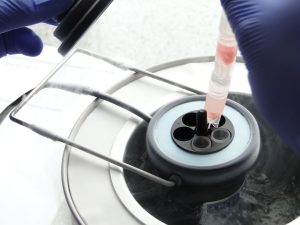Predicting Late-Effects in Cancer Treatments
Chemo- and radiotherapies are sometimes very effective treatments for cancer. However, chemotherapy drugs are usually pretty indiscriminate in their work, killing not just the rapidly dividing cells of the cancer, but also other rapidly dividing cells and as such are dangerous to pregnancy.

There is also the risk of developing infertility after treatment has ceased though, due to damage done by the drugs to eggs. Likewise, radiotherapy is also effective at removing harmful cancerous tissue, but it is incredibly hard to target the cancer cells and not damage the surrounding tissue of the ovaries/testes if that is where the cancer is positioned. The field of Oncofertility is a growing area of research centred around preserving fertility in post-treatment cancer survivors.
In HIG our aim is to produce advanced models that allow the prediction and qualification of these adverse sequelae, thereby aiding clinical teams in their search for treatments that cure cancers with minimal adverse late-effects. Thus, we hope to reduce the number of cancer survivors that have impaired fertility due to the use of chemo- and radiotherapy in their treatment.
Recent Publications
Phylactou, M, Clarke, SA, Patel, B, Baggaley, C, Jayasena, CN, Kelsey, T, Comninos, AN, Dhillo, WS & Abbara, A 2021, ‘Clinical and biochemical discriminants between Functional Hypothalamic Amenorrhoea (FHA) and Polycystic Ovary Syndrome (PCOS)‘, Clinical Endocrinology, vol. Early View. https://doi.org/10.1111/cen.14402
Mamsen, LS, Charkiewicz, K, Anderson, RA, Telfer, EE, McLaughlin, M, Kelsey, TW, Kristensen, SG, Gook, DA, Ernst, E & Andersen, CY 2019, ‘Characterization of follicles in girls and young women with Turner syndrome who underwent ovarian tissue cryopreservation‘, Fertility and Sterility, vol. 111, no. 6, pp. 1217-1225.e3. https://doi.org/10.1016/j.fertnstert.2019.02.003
Abbara, A, Patel, AH, Hunjan, T, Clarke, S, Chia, G, Eng, PC, Phylactou, M, Comninos, A, Lavery, S, Trew, G, Salim, R, Rai, R, Kelsey, TW & Dhillo, W 2019, ‘FSH requirements for follicle growth during controlled ovarian stimulation‘, Frontiers in Endocrinology, vol. 10, 579. https://doi.org/10.3389/fendo.2019.00579
van der Kooi, AL, Kelsey, TW, van den Heuvel-Eibrink, M, Laven, JSE, Wallace, WHB & Anderson, RA 2019, ‘Perinatal complications in female survivors of cancer: a systematic review and meta-analysis‘, European Journal of Cancer, vol. 111, pp. 126-137. https://doi.org/10.1016/j.ejca.2019.01.104